Kingston DC400: capacious SSD for reasonable money
Hi GT! At the very end of August, Kingston introduced a line of solid-state drives for entry-level data centers. It was named the DC400 and so far consists of six models that differ in size: from 400 to 1800 GB.
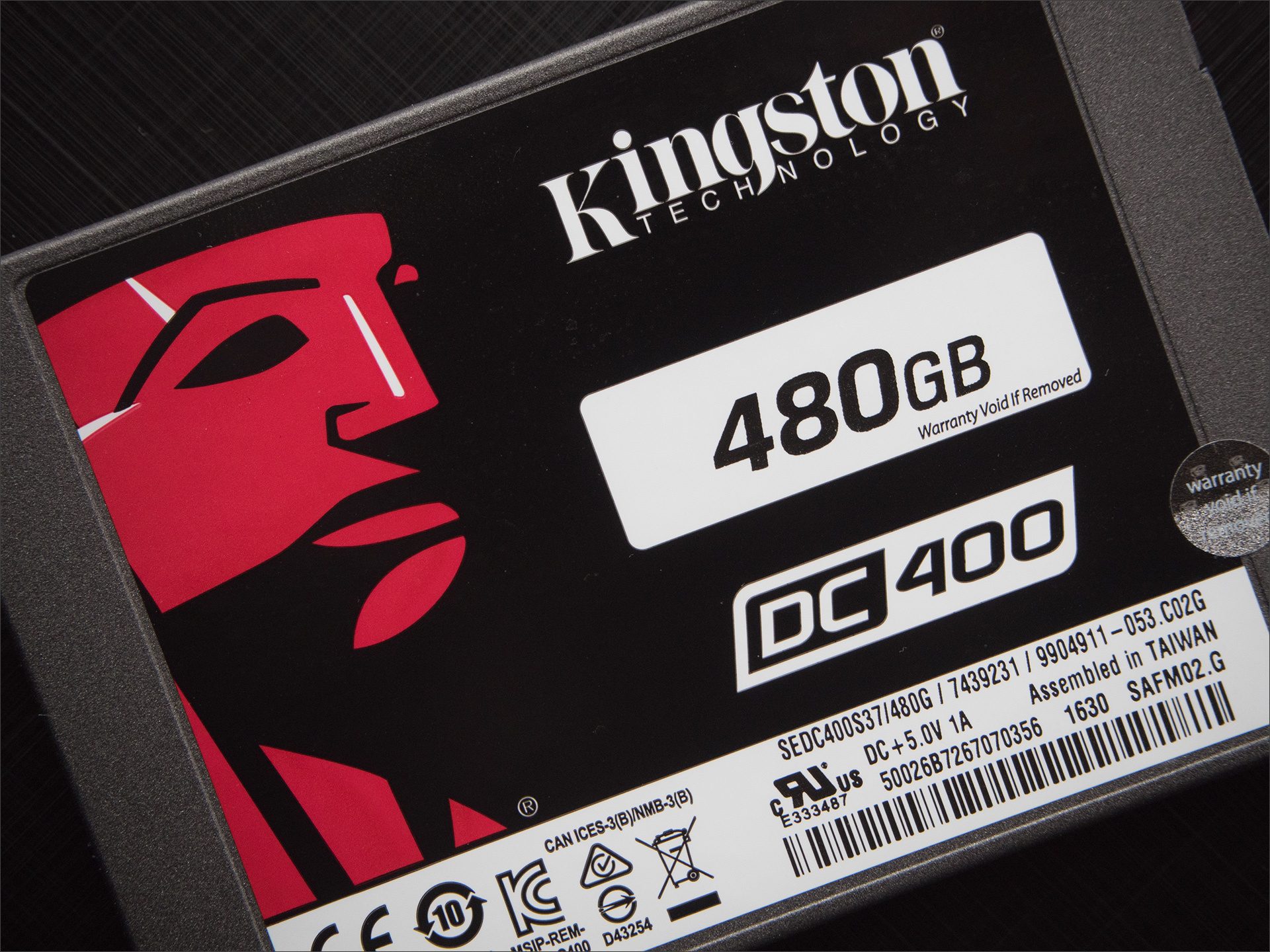
How do these SSDs differ from ordinary consumer ones? There are actually quite a few differences. In the first place - the firmware and controller behavior, more stringent conditions at the Quality Control Department, the second - an extended warranty and sharpening for very specific use cases. Let's go through all the properties in order.
The SSD itself is made in a completely classic form factor: 2.5 ", 7 millimeters thick, metal case-radiator. The technical specifications are as follows:
')
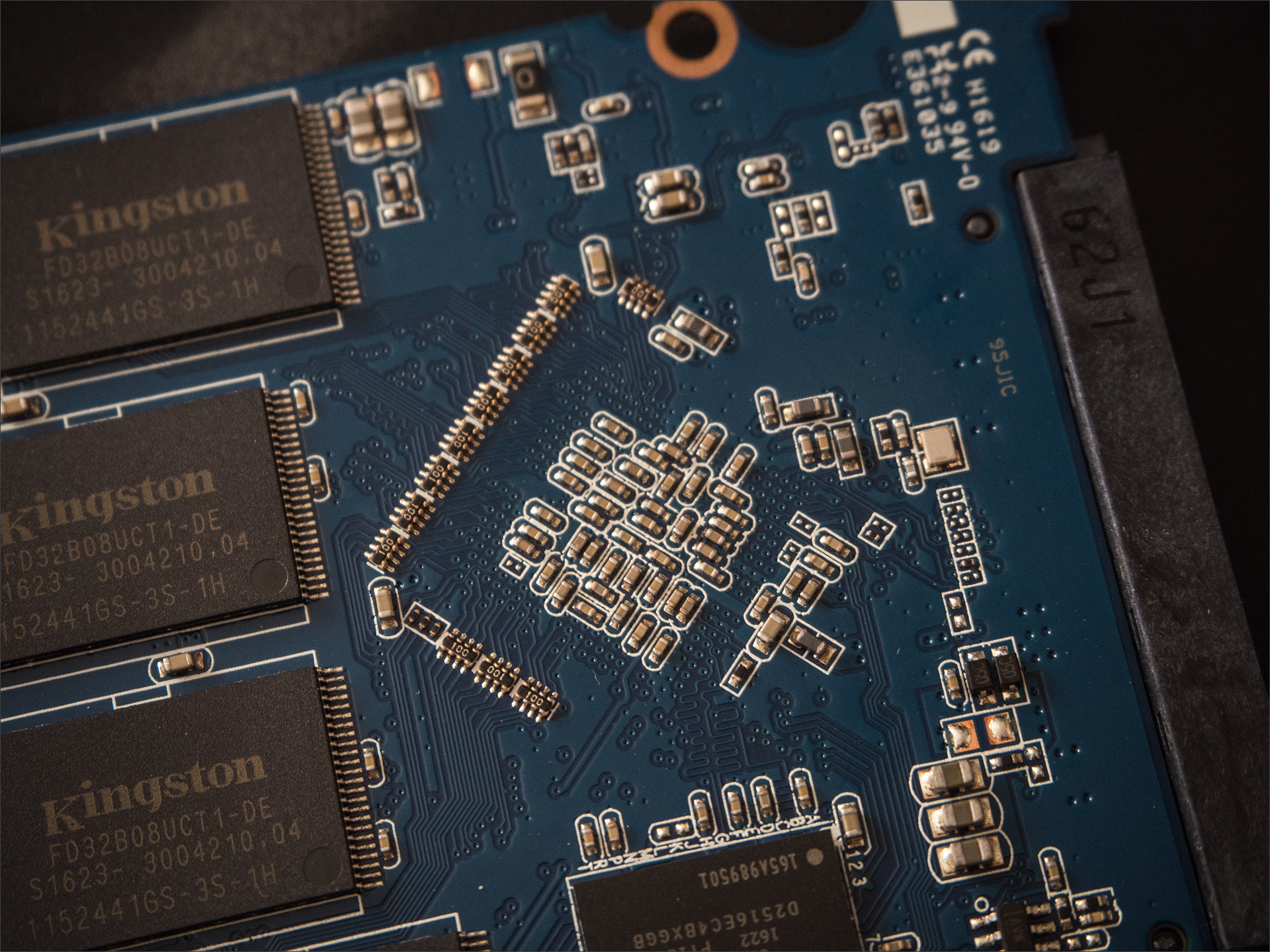
First of all, I would like to mention the controller used in this model. Phison PS3110-S10 began to be actively used in real products in the second half of 2015, and it just so happened that it mostly got into models that could be described as “high performance entry level”. Among the advantages are up to 100,000 IOPS in 4K read mode and up to ~ 90,000 IOPS when writing, as well as linear speeds in the region of 500-550 MB / s.
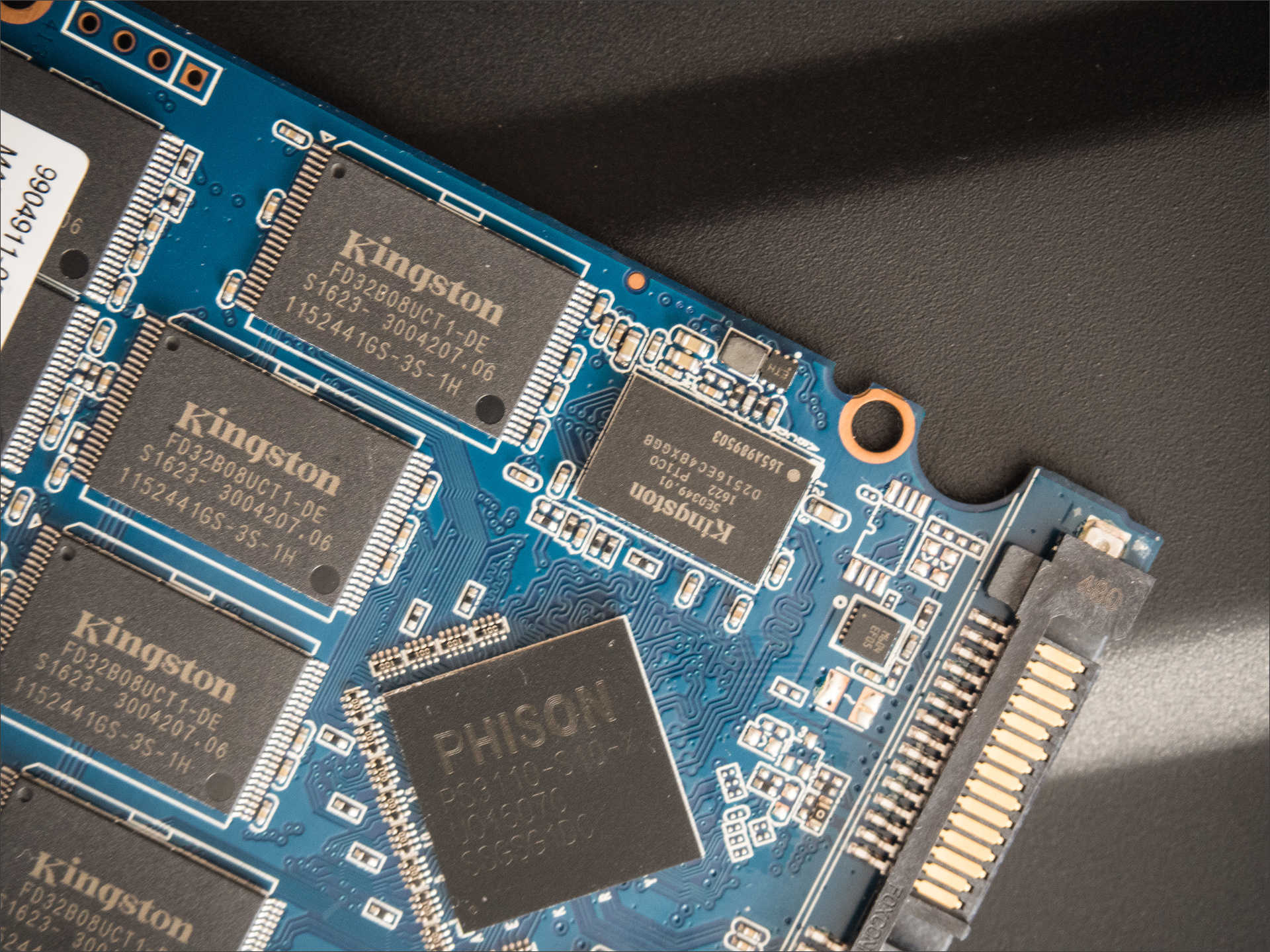
There is no protection against power loss at the hardware level, but a special program and work with correction and data recovery codes allows to correct possible errors.
In models with a “round” volume (400, 800, 1600), the main scenario implies slightly larger recording volumes than on models with 480, 960 and 1800 GB of memory. Both the controller and the number of results in the benchmark will differ accordingly. In our case, the tests were conducted on the 480 GB version, which is a universal mid-range in performance and potentially the most popular solution. However, Kingston engineers have foreseen the fact that they simply may not have the version you need, and they allow you to turn 480, 960 and 1800 gigovki into their “server” counterparts through a proprietary utility in just one click.
Software to diagnose and configure the disk looks very simple. On the left, choose a disk (in the picture it is one, but do you have a whole bunch of SSD's?), On the right, perform the operations. Controller firmware upgrade, SMART diagnostics, event log, disk re-markup and secure erasure at your service. For the last two functions, you must manually delete all partitions from the disk.

You can choose which part of the total amount to reserve for an increase in the daily resource available for recording. At the same time, the time required to saturate a disk with writing loads (for example, random data of 4 KB) will grow somewhat. As in any business, moderation is needed here: having reserved an additional 10-15% you will achieve almost nothing, and giving half of the disk to “unallocated space” almost does not get bonuses as compared to reserving ~ 30% of the volume. With such parameters, one can expect an increase in performance with intensive recording (from 20 to 40% of the total load) almost doubled.
Since the DC400 is an entry-level ruler for data centers and workstations, expect good results from it with a constant high write load ... a bit strange. Of course, the drive is still much faster than consumer SSDs (and more reliably), but its main strengths are revealed if the reading amounts to more than 70-80% of the loads. These features are taken into account in the controller firmware: at the forefront is the speed of reading and the preservation of not the greatest resource of cells. With intensive load (large write volumes by random blocks for a long period of time) the “garbage collector” does not come into play until 90-95% of free-to-write blocks are exhausted, and then optimizes the data at once, freeing up a consistent section for new data.

Thus, short and intensive write loads (from 20-30 minutes to ~ an hour) the disk operates at full capacity, after which the controller “brings order” to the disk and redistributes the data to optimize further work. When used in a workstation (for working with video, 3D graphics, heavy loads on assembling projects), the user is more likely to never experience a decrease in disk subsystem performance. In such a situation, the ratio of resource, price, high performance and stability of delays is obtained, if not ideal, then very close to it.
For high-load databases, it is worth picking up something on the SLC: if not with such an impressive amount, but with aggressive algorithms that allow you to implement a more robust NAND type of memory.
The two main test packages that drive in SSD tests are, of course, ATTO Disk Benchmark and Crystal DiskMark64 . The first disc producers themselves do not shun, and in most cases the results fly from it to online materials, packaging and press releases. The second became a classic, because in one click it allows you to get rid of 4 tests at once with the most popular scenarios: sequential reading and writing, reading and writing in random blocks of 4K and the same measurements with 32 write commands in the queue. Thus, the test covers both linear “real” copying and the speed of work in two modes: simple, everyday, and high-loaded.
The results of the final testing do not cause questions, the testimony turned out higher passport. The disk was not prepared in any special way, it was marked up with normal NTFS on 90% of capacity and filled up by about a quarter with working files in order to more accurately simulate real conditions:

Starting from 64 Kb data blocks, the speeds are the same as those specified by the manufacturer. However, it was not by chance that I indicated that only the results of the final testing were normal: the disk was initially connected to SATA III 6 GB / s port, and the results were, to put it mildly, strange:
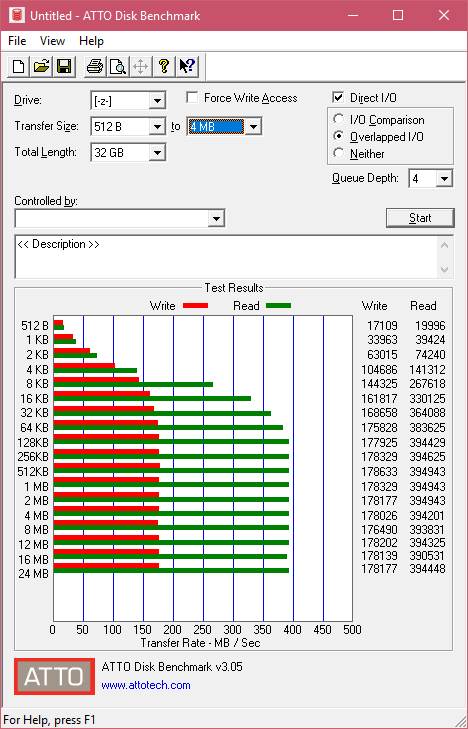
It turned out that the manufacturer of the motherboard part of the ports was not built on the SATA controller built into the processor, but on the additional Marvell chip, whose bandwidth even despite the stated SATA III support turned out to be, as you see, not as good as we would like. Hence the conclusion - do not rush to blame the manufacturer of the disc, check the connection connector and the type of cable.

The results of this bench are much closer to what can be obtained with real disk usage:

Sequential reading and writing with a long queue of commands - as in a passport, with single teams - slightly lower, but not critical. The worst thing is, of course, with the recording of small blocks, and even without a deep sequence: the disk must be rewritten blocks, which are much larger than the variable amount of data, and the lack of commands for reserve does not allow the controller to optimize the recording process and group the changes of the blocks. Compare the 4K and 4KQ32T1 results: the difference in reading is almost ten times, in writing - three times.
Measuring disk efficiency in real-life tasks is quite difficult. The PC Mark 8 has a disk test that emulates the work in Adobe graphics packages, and we can use it:
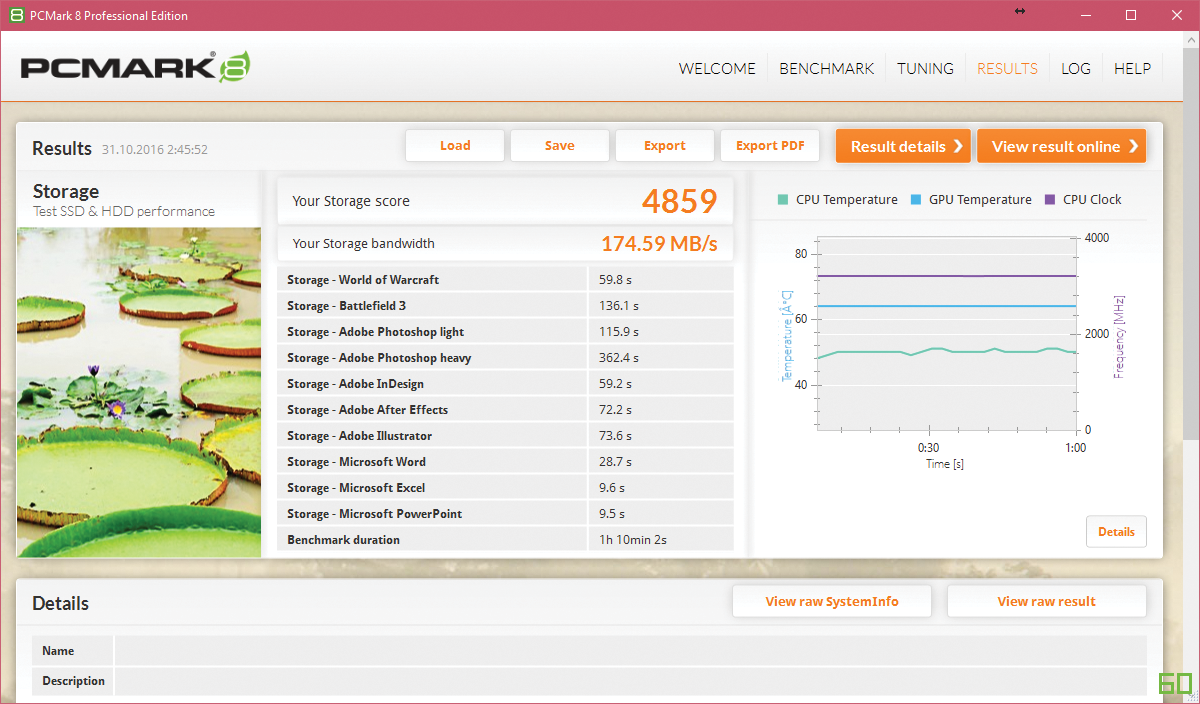
From myself, I’m ready to add that working in Photoshop with a set of photos with proper setup of the working environment is a real pleasure. That retouching one huge photo in 16-bit mode per channel is processing a whole package of photos using a macro pattern.
The model with a capacity of 480 GB is primarily designed for installation in workstations: if you use it for its intended purpose, then during a working day, even with the most intense load, you simply do not have time to write so much data for the controller to start emergency cleaning and block release under the record. But server models, such as the 1600-gig version, may well face a similar problem. The algorithm of cleaning and preparation of blocks is intentionally made "lazy": the controller saves disk resource and tries once again not to actively rewrite the blocks. Why he behaves so we have already said, but an example of the results of his work.

The company Truesystem in its blog conducted a detailed test of the server DC400 with a capacity of 1600 GB in the current environment. The graph clearly shows the work of garbage collection:

During the long hours of recording by random blocks of 4Kb (for which this disk was simply not calculated), the speed of work is almost halved, but it remains at a quite decent level of 25,000 IOPS. For comparison, some models in the same price segment can experience a drop in performance of five times, and even more.

Excellent performance cannot be wasted. DC400 - a typical "corporate" drive with a five-year warranty. In principle, if you work with graphics, photography, video, compile complex projects, you can pay a little extra for reliability and improved performance, but in all other tasks of a home or gaming computer, the HyperX consumer line will significantly save: a couple of thousand for a younger model least.

Prices for the Kingston DC400 SSD-drive start at 14,500 rubles for the 400-480 GB version. For 800-960 GB will have to pay about 24-25 thousand rubles. More volumetric models for 1600-1800 GB will appear in retail after the new year. Expensive? It depends on what you compare it to. Consumer SSDs are cheaper, but have completely different characteristics with long loads and low resource. And solutions aimed at the same segment usually cost a little more than the dc400 series. It turns out that this is the golden mean?
Even if you already have an SSD and you are not planning to purchase a new one, we know how to make you happy for the new year. There is not a lot of RAM, so we give you a 12% discount on all available DDR4 Predator models on the Ulmart network. Arm with a promotional code GEEKPR16 and have time to buy high-speed memory until December 31, 2016.
For more information about Kingston and HyperX products, visit the company's official website . In choosing your kit HyperX help page with visual aids .

How do these SSDs differ from ordinary consumer ones? There are actually quite a few differences. In the first place - the firmware and controller behavior, more stringent conditions at the Quality Control Department, the second - an extended warranty and sharpening for very specific use cases. Let's go through all the properties in order.
Specifications
The SSD itself is made in a completely classic form factor: 2.5 ", 7 millimeters thick, metal case-radiator. The technical specifications are as follows:
')
Volume: 400, 480, 800, 960, 1600 and 1800 GB;
Interface: SATA III 6 Gb / s;
Memory Type: 15nm MLC NAND;
Controller: four-core Phison PS3110-S10;
Performance
- Sequential access:
- Reading - 555 MB / s
- Record - 500+ Mb / s
- Random access:
- 400 GB - 99,000 / 90,000 IOPS
- 480 GB - 99,000 / 90,000 IOPS
- 800 GB - 99,000 / 89,000 IOPS
- 960 GB - 99,000 / 88,000 IOPS
- 1600 GB - 100 000/88 000 IOPS
- 1800 GB - 99,000 / 86,000 IOPS
- QoS Delay: 4 kilobyte unit, random access, 4 ms for 99.9%
Emulated sector size: 512 bytes
Resource:
- 400 GB - 422 TB (0.57 DWPD)
- 480 GB - 257 TB (0.30 DWPD)
- 800 GB - 860 TB (0.58 DWPD)
- 960 GB - 564 TB (0.32 DWPD)
- 1600 GB - 1678 TB (0.57 DWPD)
- 1800 GB - 1432 TB (0.43 DWPD)
Warranty period: 5 years

Iron features
First of all, I would like to mention the controller used in this model. Phison PS3110-S10 began to be actively used in real products in the second half of 2015, and it just so happened that it mostly got into models that could be described as “high performance entry level”. Among the advantages are up to 100,000 IOPS in 4K read mode and up to ~ 90,000 IOPS when writing, as well as linear speeds in the region of 500-550 MB / s.

There is no protection against power loss at the hardware level, but a special program and work with correction and data recovery codes allows to correct possible errors.
In models with a “round” volume (400, 800, 1600), the main scenario implies slightly larger recording volumes than on models with 480, 960 and 1800 GB of memory. Both the controller and the number of results in the benchmark will differ accordingly. In our case, the tests were conducted on the 480 GB version, which is a universal mid-range in performance and potentially the most popular solution. However, Kingston engineers have foreseen the fact that they simply may not have the version you need, and they allow you to turn 480, 960 and 1800 gigovki into their “server” counterparts through a proprietary utility in just one click.
Kingston SSD Manager
Software to diagnose and configure the disk looks very simple. On the left, choose a disk (in the picture it is one, but do you have a whole bunch of SSD's?), On the right, perform the operations. Controller firmware upgrade, SMART diagnostics, event log, disk re-markup and secure erasure at your service. For the last two functions, you must manually delete all partitions from the disk.

You can choose which part of the total amount to reserve for an increase in the daily resource available for recording. At the same time, the time required to saturate a disk with writing loads (for example, random data of 4 KB) will grow somewhat. As in any business, moderation is needed here: having reserved an additional 10-15% you will achieve almost nothing, and giving half of the disk to “unallocated space” almost does not get bonuses as compared to reserving ~ 30% of the volume. With such parameters, one can expect an increase in performance with intensive recording (from 20 to 40% of the total load) almost doubled.
Key Usage Scenarios
Since the DC400 is an entry-level ruler for data centers and workstations, expect good results from it with a constant high write load ... a bit strange. Of course, the drive is still much faster than consumer SSDs (and more reliably), but its main strengths are revealed if the reading amounts to more than 70-80% of the loads. These features are taken into account in the controller firmware: at the forefront is the speed of reading and the preservation of not the greatest resource of cells. With intensive load (large write volumes by random blocks for a long period of time) the “garbage collector” does not come into play until 90-95% of free-to-write blocks are exhausted, and then optimizes the data at once, freeing up a consistent section for new data.

Thus, short and intensive write loads (from 20-30 minutes to ~ an hour) the disk operates at full capacity, after which the controller “brings order” to the disk and redistributes the data to optimize further work. When used in a workstation (for working with video, 3D graphics, heavy loads on assembling projects), the user is more likely to never experience a decrease in disk subsystem performance. In such a situation, the ratio of resource, price, high performance and stability of delays is obtained, if not ideal, then very close to it.
For high-load databases, it is worth picking up something on the SLC: if not with such an impressive amount, but with aggressive algorithms that allow you to implement a more robust NAND type of memory.
Synthetic tests
The two main test packages that drive in SSD tests are, of course, ATTO Disk Benchmark and Crystal DiskMark64 . The first disc producers themselves do not shun, and in most cases the results fly from it to online materials, packaging and press releases. The second became a classic, because in one click it allows you to get rid of 4 tests at once with the most popular scenarios: sequential reading and writing, reading and writing in random blocks of 4K and the same measurements with 32 write commands in the queue. Thus, the test covers both linear “real” copying and the speed of work in two modes: simple, everyday, and high-loaded.
ATTO Disk Benchmark
The results of the final testing do not cause questions, the testimony turned out higher passport. The disk was not prepared in any special way, it was marked up with normal NTFS on 90% of capacity and filled up by about a quarter with working files in order to more accurately simulate real conditions:

Starting from 64 Kb data blocks, the speeds are the same as those specified by the manufacturer. However, it was not by chance that I indicated that only the results of the final testing were normal: the disk was initially connected to SATA III 6 GB / s port, and the results were, to put it mildly, strange:

It turned out that the manufacturer of the motherboard part of the ports was not built on the SATA controller built into the processor, but on the additional Marvell chip, whose bandwidth even despite the stated SATA III support turned out to be, as you see, not as good as we would like. Hence the conclusion - do not rush to blame the manufacturer of the disc, check the connection connector and the type of cable.

Crystal disk
The results of this bench are much closer to what can be obtained with real disk usage:

Sequential reading and writing with a long queue of commands - as in a passport, with single teams - slightly lower, but not critical. The worst thing is, of course, with the recording of small blocks, and even without a deep sequence: the disk must be rewritten blocks, which are much larger than the variable amount of data, and the lack of commands for reserve does not allow the controller to optimize the recording process and group the changes of the blocks. Compare the 4K and 4KQ32T1 results: the difference in reading is almost ten times, in writing - three times.
Real loads
Measuring disk efficiency in real-life tasks is quite difficult. The PC Mark 8 has a disk test that emulates the work in Adobe graphics packages, and we can use it:

From myself, I’m ready to add that working in Photoshop with a set of photos with proper setup of the working environment is a real pleasure. That retouching one huge photo in 16-bit mode per channel is processing a whole package of photos using a macro pattern.
Long recording and speed reduction
The model with a capacity of 480 GB is primarily designed for installation in workstations: if you use it for its intended purpose, then during a working day, even with the most intense load, you simply do not have time to write so much data for the controller to start emergency cleaning and block release under the record. But server models, such as the 1600-gig version, may well face a similar problem. The algorithm of cleaning and preparation of blocks is intentionally made "lazy": the controller saves disk resource and tries once again not to actively rewrite the blocks. Why he behaves so we have already said, but an example of the results of his work.

The company Truesystem in its blog conducted a detailed test of the server DC400 with a capacity of 1600 GB in the current environment. The graph clearly shows the work of garbage collection:

During the long hours of recording by random blocks of 4Kb (for which this disk was simply not calculated), the speed of work is almost halved, but it remains at a quite decent level of 25,000 IOPS. For comparison, some models in the same price segment can experience a drop in performance of five times, and even more.

In total
Excellent performance cannot be wasted. DC400 - a typical "corporate" drive with a five-year warranty. In principle, if you work with graphics, photography, video, compile complex projects, you can pay a little extra for reliability and improved performance, but in all other tasks of a home or gaming computer, the HyperX consumer line will significantly save: a couple of thousand for a younger model least.

Prices for the Kingston DC400 SSD-drive start at 14,500 rubles for the 400-480 GB version. For 800-960 GB will have to pay about 24-25 thousand rubles. More volumetric models for 1600-1800 GB will appear in retail after the new year. Expensive? It depends on what you compare it to. Consumer SSDs are cheaper, but have completely different characteristics with long loads and low resource. And solutions aimed at the same segment usually cost a little more than the dc400 series. It turns out that this is the golden mean?
Even if you already have an SSD and you are not planning to purchase a new one, we know how to make you happy for the new year. There is not a lot of RAM, so we give you a 12% discount on all available DDR4 Predator models on the Ulmart network. Arm with a promotional code GEEKPR16 and have time to buy high-speed memory until December 31, 2016.
For more information about Kingston and HyperX products, visit the company's official website . In choosing your kit HyperX help page with visual aids .
Source: https://habr.com/ru/post/372763/
All Articles